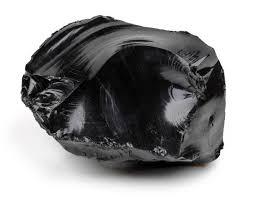Obsidian is a naturally occurring volcanic glass formed when molten lava cools rapidly with minimal crystal growth. Its surface is typically smooth and glass-like, ranging from deep black to shimmering golden, silver, mahogany, and even rainbow variations. Because of its origin, Obsidian carries a raw, intense energy often associated with grounding, protection, truth-revealing, and self-discovery. It has been used for thousands of years for tools, blades, mirrors, and spiritual practices.
Obsidian is an igneous mineraloid composed primarily of silica. Its texture is smooth and conchoidal, meaning it breaks into sharp, curved fragments—one reason ancient cultures relied on obsidian for blades and cutting tools. Today, it is widely used in jewelry, carvings, spheres, and meditation tools. Though commonly associated with a rich, deep black color, its appearance varies depending on mineral inclusions, air bubbles, and volcanic conditions. This results in variations such as Mahogany, Snowflake, Sheen, Rainbow, and Apache Tear Obsidian.
- Composition: Volcanic glass rich in silica
- Hardness: ~5–5.5 on the Mohs scale
- Luster: Glassy, smooth, reflective
- Colors: Typically black, but occurs in several visually distinct varieties
Historical & Cultural Background
Obsidian has been used since the Stone Age, valued for its sharpness and workability. Many early cultures, including the Maya, Aztec, and ancient Greeks, fashioned obsidian into arrowheads, ceremonial knives, and ritual tools. Archaeological sites across Mesoamerica contain obsidian mirrors, which were used in divination and communication with the spirit world. The Aztec deity Tezcatlipoca, whose name translates to “Smoking Mirror,” was closely associated with obsidian, symbolizing mystery, transformation, and the unknown. In ancient Mediterranean civilizations, obsidian was considered a protective stone, thought to ward off ill intentions and the “evil eye.” Shamans and spiritual practitioners have long used polished obsidian as a scrying tool, gazing into its reflective surface for visions and guidance. Across cultures, obsidian has been consistently linked to truth, unveiling, protection, and boundary-setting, themes that continue into modern metaphysical practice.
- Mesoamerican cultures carved mirrors for scrying and divination.
- Indigenous peoples of North America formed arrowheads and knives from it.
- Ancient Greeks and Romans believed it offered protection from negative forces.
- Shamans across cultures used obsidian as a spiritual “gateway” stone for shadow work—understanding hidden emotions and past experiences.
Its sharpness and reflective qualities gave it a dual symbolism: piercing truth and self-reflection.
Metaphysical Meanings
Obsidian is widely recognized as a stone of protection, grounding, and clarity. It is believed to create a spiritual and emotional barrier that shields the user from negativity, psychic intrusion, and emotional attack. However, obsidian does more than protect—it reveals. Many experience it as a mirror to the subconscious, drawing out repressed emotions, hidden truths, and forgotten memories. Because of this, it is often recommended for those ready to confront their shadow self and begin a process of deep internal transformation. In healing work, obsidian is associated with the Root Chakra, where it stabilizes the energy field and promotes security, presence, and physical grounding. Its energy is direct, strong, and sometimes intense—making it valued in practices that involve emotional release or spiritual cleansing. Rather than offering gentle comfort, obsidian cuts through illusions and supports the process of acknowledging what is real, necessary, and healthy.
- Grounds energy into the body and Earth
- Shields against negativity and emotional drain
- Reveals hidden truths and emotional patterns
- Enhances shadow work and psychological insight
- Helps break outdated patterns
Obsidian is direct and unfiltered. It does not soften truths—it exposes them for the sake of growth.
Varieties of Obsidian & Their Meanings
Black Obsidian
Deep protective energy; excellent for grounding and clearing negative influences.
- Appearance: Deep black, glassy, reflective
- Energy: Grounding, clearing, protective
- Associations: Root Chakra Used for strong protection and releasing heavy or stuck emotional energy.
Rainbow Obsidian
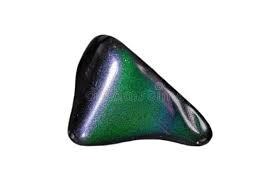
Known for its iridescent bands visible under light.
- Colors: Purple, green, gold, or pink layers
- Energy: Protective but gentler, heart-opening, emotional healing Helps soothe grief and supports emotional recovery.
Mahogany Obsidian

Red-brown patches formed from iron inclusions. A gentler grounding stone with supportive energy for personal strength and self-worth.
- Energy: Stabilizing, strengthening, confidence-building Supports boundaries and resilience without being overwhelming.
Snowflake Obsidian
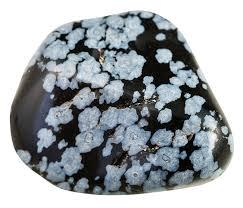
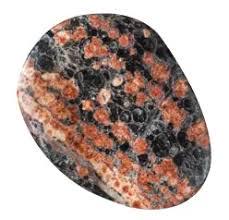
Black obsidian with white cristobalite inclusions resembling snowflakes.
- Energy: Calm, balance, acceptance, processing change Useful for soothing internal conflict and stabilizing mood.
Gold Sheen & Silver Sheen Obsidian
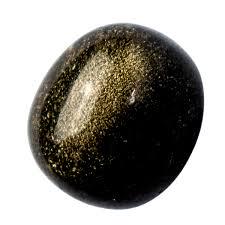
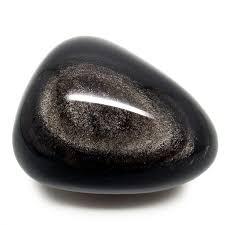
Reflective metallic sheen created by trapped gas layers.
- Gold Sheen: Willpower, manifestation, clarity of direction
- Silver Sheen: Self-reflection, inner truth, life purpose exploration Often used in scrying and meditation work.
Apache Tears
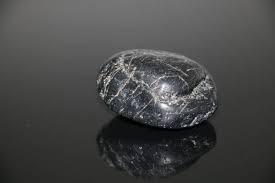
Small, rounded obsidian nodules that appear translucent when held to light.
- Energy: Gentle grief support, emotional release, grounding Traditionally used as a comfort stone during mourning.
How to Use Obsidian
Obsidian can be worn, placed in the home, used in meditation, or incorporated into grounding rituals. Because of its strong clearing energy, it is commonly placed near entryways or workspaces to dispel absorbed negativity. When used for meditation or shadow work, many prefer to pair it with gentler stones such as Rhodonite, Lepidolite, or Rose Quartz to support emotional processing.
- Meditation: Encourages truth and inner clarity
- Jewelry: Maintains energetic protection throughout the day
- Home Placement: Near entryways to discourage negative energy
- Shadow Work: Journaling or emotional processing sessions
- Scrying: Sheen obsidian is ideal for reflective meditation
Care & Cleansing
Obsidian does not require complicated care, though it benefits from regular energetic cleansing if used for emotional or protective purposes. It is durable but can scratch or chip due to its glassy nature.
- Clean with water and a soft cloth (no abrasive materials).
- Avoid dropping—its edges can chip.
- Energetically cleanse using:
- Smoke cleansing (sage, palo santo, incense)
- Moonlight
- Sound cleansing (bells, chimes, singing bowls)
- Place on selenite or hematite
Do not cleanse with salt—it may scratch the surface. Unlike many crystals, obsidian does not fade in sunlight and is structurally durable, but treat it carefully due to its natural glass-like composition.
Final Thoughts
Obsidian is not a gentle stone—it is honest, cleansing, and revealing. It is ideal for those ready to heal deeply rooted patterns, protect their energy, and gain clarity about themselves. With its many variations, each offering a unique tone of guidance and support, Obsidian remains one of the most powerful and transformative stones available.
